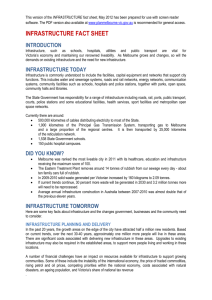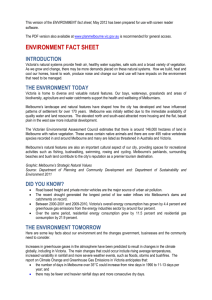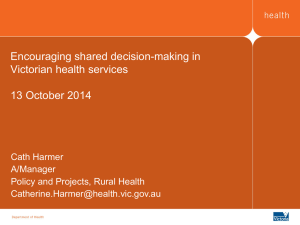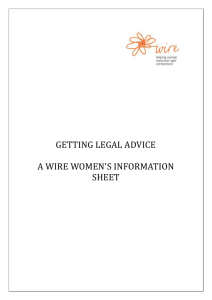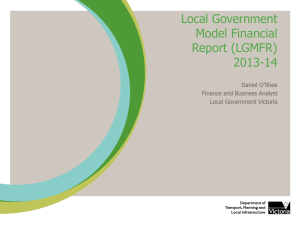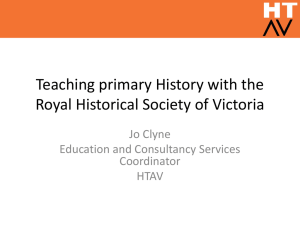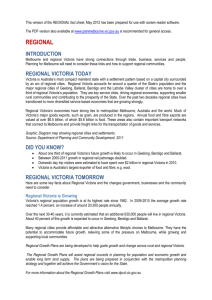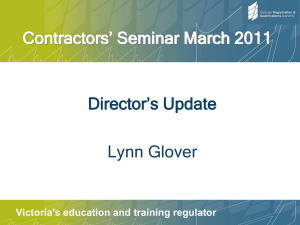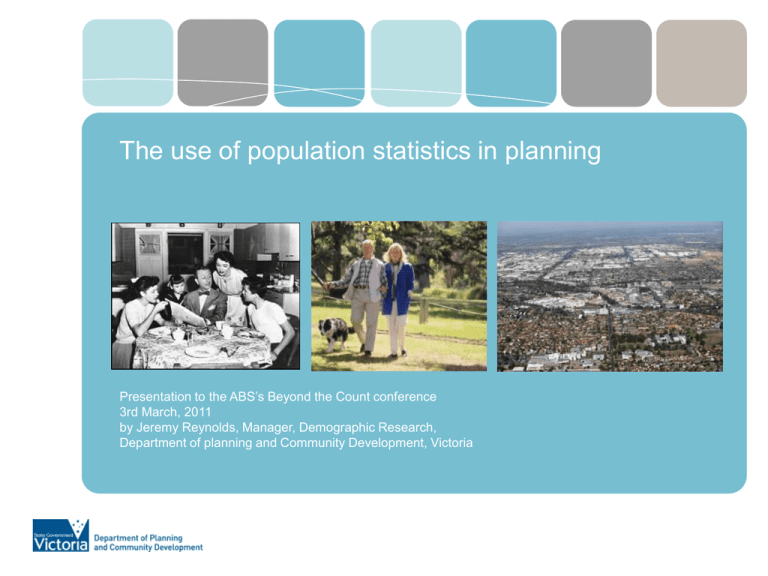
The use of population statistics in planning
Presentation to the ABS’s Beyond the Count conference
3rd March, 2011
by Jeremy Reynolds, Manager, Demographic Research,
Department of planning and Community Development, Victoria
The basics: How many people?
How many voters? How much money are areas granted?
Photo: Simon O’Dwyer - Courtesy of “The Age”
But different people have different needs …..
The symbolic importance of population
Annual population growth, Australia,
1789-2009
Persons
500,000
2009
+432,180
400,000
300,000
1950
+261,911
1988
+292,441
1919
+222,662
200,000
1855
+98,343
100,000
1883
+117,654
1942
+57,498
1841
+30,560
0
-100,000
1789
2009
Source:
ABS, Australian Historical Population Statistics (Cat. no. 3105.0.65.001)
Australian Demographic Statistics (Cat. no. 3101.0)
Contrasting population growth:
last 40 years versus next 40 years
Melbourne
Regional Victoria
Population growth
1970-2010
Projected
population growth
2010-2050
1,588,000
2,085,000*
465,000
567,000*
Victoria
2,053,000
2,652,000*
Australia
9,445,000
11,759,000**
13,700,000***
* Victoria in Future 2008 (Vic Govt)
** ABS Series B (2008)
*** Intergenerational Report 3 (2010)
NB All projections assume NOM of 180,000 p.a.. Fertility rate assumptions:
VIF/ABS 1.8 (Aus), 1.73 (Vic). IGR3 assumes 1.92 (Aus)
Contrasting average annual population
growth rates: last 40 years versus next 40 years
Average annual
growth rate
1970-2010
Projected average
annual growth rate
2010-2050
Melbourne
1.3%
1.0%*
Regional Victoria
1.0%
0.8%*
Victoria
1.2%
1.0%* **
Australia
1.4%
1.1%**
1.2%***
* Victoria in Future 2008 (Vic Govt)
** ABS Series B (2008)
*** Intergenerational Report 3 (2010)
NB All projections assume NOM of 180,000 p.a.. Fertility rate assumptions:
VIF/ABS 1.8 (Aus), 1.73 (Vic). IGR3 assumes 1.92 (Aus)
The challenge of population growth
The head of the Treasury, Ken Henry, says Australia's population
growth is the biggest challenge to Commonwealth and state
governments since Federation.
Giving a speech in Brisbane on 22/10/09, Mr Henry talked about a
projected 60 per cent increase in population by 2050.
He said the challenge would require national leadership on urban
development.
Source: ABC, October 2009
The four main reasons why the census is so
valuable for users
1. Reliable and thorough
2. Wide range of data than can be cross tabulated
3. Time series
4. Geographical detail
1. The ABS - reliable and thorough
collector of information
2. Wide range of related data about the population,
what it does and about the housing stock
Population - place of enumeration
Population - usual residence
Age/sex of population
Marital status
‘Ethnicity’ indicators
Religion
Fertility indicator
Volunteerism
Income
Household and family composition
Dwelling type, tenure
Rent and mortgage payments
Internet connection
Workforce – labour force status,
Industry
Occupation
Hours worked
Place of work,
Mode of travel to work,
Education qualifications
Internal migration – place of
residence one and five years
previously
Indigenous population profile
Socio–economic Index (SEIFA)
2. Cross tabulating: People needing assistance
by age, Victoria, 2006
3. Time series data
1991 to 2001
3. Time series data: Inner city population
change over the last 50 years, Melbourne and Sydney
4. Geographical detail
4. Geographical detail: population change
across Victoria between 2001 and 2006
5,000
5,000
2,000
2,000
500
500
-500
-500
-2,000
-2,000
-5,000
-5,000
Bendigo
Ballarat
Geelong
4. Geographical detail
Proportion of Population aged 18 to 34 in 2006
40.0
Melbourne
Difference to
state average
30.0
Yarra
Port Phillip
20.0
Melb - Inner
10.0
(State Average = 23.3%)
0.0
-10.0
-20.0
-30.0
-40.0
Department of Planning and Community Development. Census 2006 Analysis.
For further information contact the Spatial Analysis & Research Branch
Tel: 9637 9441 Email: spatialanalysis.research@dpcd.vic.gov.au
4. Geographical detail
Proportion of population with low proficiency in English,
2006
Difference to
state average
25.0
5.0
Hobsons Bay
10.0
Vic Gov - Northern And
Western Metropolitan
Hume
15.0
Brimbank
Maribyrnong
Yarra
Darebin
Moreland
Whittlesea
Moonee Valley
20.0
(State Average = 12.9%)
-15.0
-20.0
-25.0
Department of Planning and Community Development. Census 2006 Analysis.
For further information contact the Spatial Analysis & Research Branch
Tel: 9637 9441 Email: spatialanalysis.research@dpcd.vic.gov.au
Nillumbik
-10.0
Wyndham
Melbourne
Melton
-5.0
Banyule
0.0
Value adding information
Monitoring
Data
Decision
making
capacity
Editing &
Compiling
Information
Knowledge
Understanding
Analysis
Gathering evidence for decisions
Monitoring
Data
Informed
decision
making
Editing
Compiling
Information
Knowledge
Understanding
Analysis
Fluctuations in the weekday population
of the City of Melbourne
350,000
300,000
LGA Population
250,000
200,000
150,000
100,000
50,000
0
400
500
600
700
800
900
1000 1100 1200 1300 1400 1500 1600 1700 1800 1900 2000 2100 2200 2300 2400 2500 2600 2700
Hour
Residents - At Home
Residents - At Work
Residents - Other
Non-Residents - At Work
Non-Residents - Other
And you were wondering why you don’t get
a seat on the train these days!
Non-resident populations
Estimated population
William Creek: population of 2 or has it
has many populations?
The use of population statistics in planning
Presentation to the ABS’s Beyond the Count conference
3rd March, 2011
by Jeremy Reynolds, Manager, Demographic Research,
Department of planning and Community Development, Victoria


